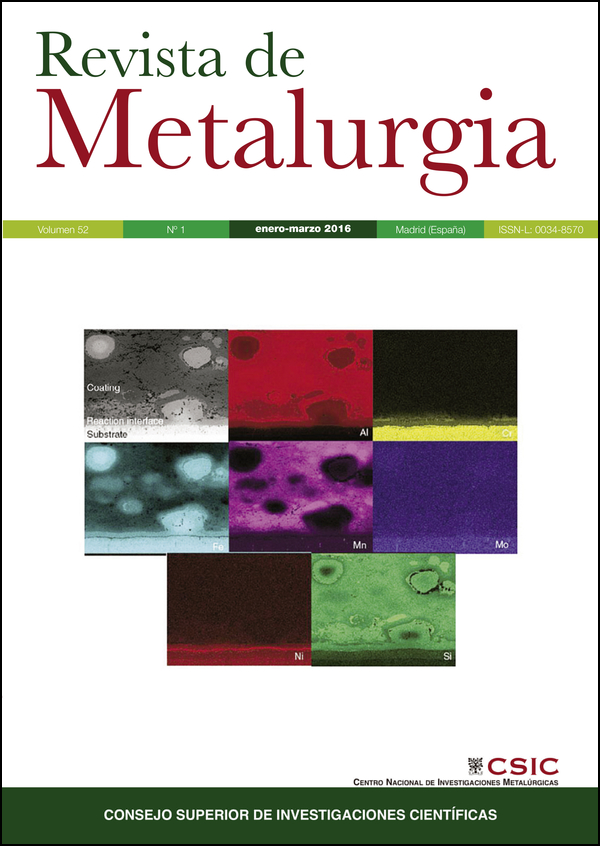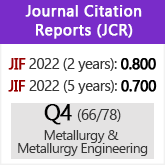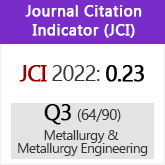Direct measurement of the adsorption kinetics of 2-Mercaptobenzothiazole on a microcrystalline copper surface
DOI:
https://doi.org/10.3989/revmetalm.064Keywords:
EQCM, Free energy of adsorption, Langmuir isotherm, 2-MBTAbstract
The adsorption on copper of 2-Mercaptobenzothiazole (2-MBT), a eterocyclic compound member of the tiazole family, has been investigated at different concentrations (1×10−1 to 1×10−6 M) in water, employing the Electrochemical Quartz Crystal Microbalance (EQCM). The frequency response over time was obtained for each concentration, showing a defined exponential behavior at higher concentrations (1×10−1, 1×10−2 and 1×10−3 M), which was fitted to the Langmuir adsorption isotherm with a good correlation coefficients (R2=0.91 to 0.98). Surface coverage (θ) was calculated and found to be in the order of 0.50 to 0.01 for 2-MBT high concentrations. The free energy of adsorption was ΔGads=−5.59 kJ mol−1, corresponding to physisorption process, probably of electrostatic nature of the interaction between 2-MBT and copper surface in aqueous solution.
Downloads
References
Aballe, A., Bethencourt, M., Botana, F.J., Marcos, M., Pérez, J., Rodríguez, M.A. (1997). Inhibidores de escaso impacto ambiental. Sistemas basados en tierras raras. Rev. Metal. 33 (6), 363–369.
Allam, N.K., Nazer, A.A., Ashour, E.A. (2009). A review of the effects of bezotriazole on the corrosion of copper and copper alloys in clean and polluted environments. J. Appl. Electrochem. 39, 961–969. http://dx.doi.org/10.1007/s10800-009-9779-4
Antonijevic, M.M., Petrovic, M.B. (2008). Copper Corrosion Inhibitors. A review. Int. J. Electrochem. Sci. 3, 1–28.
Atkins, P.W. (1999). Physical Chemistry. Oxford University Press, pp. 857–858.
Behpour, M., Mohammadi, N. (2012). Investigation of inhibition properties of aromatic thiol self-assembled monolayer for corrosion protection. Corros. Sci. 65, 331–339. http://dx.doi.org/10.1016/j.corsci.2012.08.036
Chadwick, D., Hashemi, T. (1979). Electron spectroscopy of corrosion inhibitors: Surface films formed by 2-mercap- tobenzothiazole and 2-mercaptobenzimidazole on copper. Surf. Sci. 89 (1–3), 649–659. http://dx.doi.org/10.1016/0039-6028(79)90646-0
Davis, J.R. (2001). ASM Specialty Handbook: Copper and Copper Alloys. ASM International.
Eickes, C., Rosenmund, J., Wasle, S., Doblhofer, K., Wang, K., Weil, K.G. (2000). The electrochemical quartz crystal microbalance (EQCM) in the studies of complex electrochemical reactions. Electrochim. Acta 45 (22–23), 3623–3628. http://dx.doi.org/10.1016/S0013-4686(00)00445-X
Finsgar, M., Merl, D.K. (2014). An electrochemical, long-term immersion, and XPS study of 2-mercaptobenzothiazole as a copper corrosion inhibitor in chloride solution. Corros. Sci. 83, 164–175. http://dx.doi.org/10.1016/j.corsci.2014.02.016
Godínez, L.A., Meas, Y., Ortega-Borges, R., Corona, A. (2003). Los inhibidores de corrosión. Rev. Metal. 39 (2), 140–158. http://dx.doi.org/10.3989/revmetalm.2003.v39.i2.325
Haerifar, M., Azizian, S. (2013). An exponential kinetic model for adsorption at solid/solution interface. Chem. Eng. J. 215–216, 65–71. http://dx.doi.org/10.1016/j.cej.2012.11.017
Jakeria, M.R., Fazal, M.A., Haseeb, A.S.M.A. (2015). Effect of corrosion inhibitors on corrosiveness of palm biodiesel. Corros. Eng. Sci. Techn. 50 (1), 56–62. http://dx.doi.org/10.1179/1743278214Y.0000000208
Jing, P., Hou, M., Zhao, P., Tang, X., Wan, H. (2013). Adsorption of 2-mercaptobenzothiazole from aqueous solution by organo-bentonite. J. Environ. Sci. 25 (6), 1139–1144. http://dx.doi.org/10.1016/S1001-0742(12)60166-1
Karpovich, D.S., Blanchard, G.J. (1994). Direct Measurement of the Adsorption Kinetics of Alkanethiolate Self-Assembled Monolayers on a Microcrystalline Gold Surface. Langmuir 10 (9), 3315–3322. http://dx.doi.org/10.1021/la00021a066
Kazansky, L.P., Selyaninov, I.A., Kuznetsov, Y.I. (2012). Adsorption of 2-mercaptobenzothiazole on copper surface from phosphate solutions. Appl. Surf. Sci. 258 (18), 6807–6813. http://dx.doi.org/10.1016/j.apsusc.2012.03.097
Kern, P., Landolt, D. (2001). Adsorption of organic corrosion inhibitors on iron in the active and passive state. A replacement reaction between inhibitor and water studied with the rotating quartz crystal microbalance. Electrochim. Acta 47 (4), 589–598.
Khaled, K.F., Fadl-Allah, S.A., Hammouti, B. (2009). Some benzotriazole derivatives as corrosion inhibitors for copper in acidic medium: Experimental and quantum chemical molecular dynamics approach. Mater. Chem. Phys. 117 (1), 148–155. http://dx.doi.org/10.1016/j.matchemphys.2009.05.043
Kokalj, A., Peljhan, S., Fin?gar, M., Milo?ev, I. (2010). What Determines the Inhibition Effectiveness of ATA, BTAH, and BTAOH Corrosion Inhibitors on Copper? J. Am. Chem. Soc. 132 (46), 16657–16668. http://dx.doi.org/10.1021/ja107704y PMid:21033661
Langmuir, I. (1918). The adsorption of gases on plane surfaces of glass, mica and platinum. J. Am. Chem. Soc. 40 (9), 1361–1403. http://dx.doi.org/10.1021/ja02242a004
Marconato, J.C., Bulhões, L.O., Temperini, M.L. (1998). A spectroelectrochemical study of the inhibition of the electrode process on copper by 2-mercaptobenzothiazole in ethanolic solutions. Electrochim. Acta 43 (7), 771–780. http://dx.doi.org/10.1016/S0013-4686(97)00204-1
Marczewski, A.W. (2010). Analysis of Kinetic Langmuir Model. Part I: Integrated Kinetic Langmuir Equation (IKL): A New Complete Analytical Solution of the Langmuir Rate Equation. Langmuir 26 (19), 15229–15238.
Morales-Gil, P., Walczack, M.S., Cottis, R.A., Romero, J.M., Lindsay, R. (2014). Corrosion inhibitor binding in an acidic medium: Interaction of 2-mercaptobenizmidazole with carbon-steel in hydrochloric acid. Corros. Sci. 85, 109–114. http://dx.doi.org/10.1016/j.corsci.2014.04.003
Oshawa, M., Süetaka, W. (1979). Spectro-electrochemical studies of the corrosion inhibition of copper by mercaptobenzothiazole. Corros. Sci. 19 (7), 709–722.
Pan, Y.C., Wen, Y., Guo X.Y., Song, P., Shen, S., Du, Y.P., Yang, H.F. (2013). 2-Amino-5-(4-pyridinyl)-1,3,4-thiadiazole monolayers on copper surface: Observation of the relationship between its corrosion inhibition and adsorption structure. Corros. Sci. 73, 274–280. http://dx.doi.org/10.1016/j.corsci.2013.04.016
Quraishi, M.A., Jamal, D. (2001). Corrosion inhibition by fatty acid oxadiazoles for oil well steel (N-80) and mild steel. Mater. Chem. Phys. 71 (2), 202–205. http://dx.doi.org/10.1016/S0254-0584(00)00378-3
Ramenzanzadeh, B., Arman, S.Y., Mehdipour, M., Markhali, B.P. (2014). Analysis of electrochemical noise (ECN) data in time and frequency domain for comparison corrosion inhibition of some azole compounds on Cu in 1.0 M H2SO4 solution. Appl. Surf. Sci. 289, 129–140. http://dx.doi.org/10.1016/j.apsusc.2013.10.119
Schmitt, G. (1984). Application of Inhibitors for Acid Media: Report prepared for the European Federation of Corrosion Working Party on Inhibitors. Brit. Corros. J. 19 (4), 165–176. http://dx.doi.org/10.1179/000705984798273100
Solmaz, R., Altunbas, E., Kardas, G. (2011). Adsorption and corrosion inhibition effect of 2-((5-mercapto-1,3,4-thiadiazol-2-ylimino)methyl)phenol Schiff base on mild steel. Mater. Chem. Phys. 125 (3), 796–801. http://dx.doi.org/10.1016/j.matchemphys.2010.09.056
Subramanian, R., Lakshminarayanan, V. (2000). A study of kinetics of adsorption of alkanethiols on gold using electrochemical impedance spectroscopy. Electrochim. Acta 45 (27), 4501–4509. http://dx.doi.org/10.1016/S0013-4686(00)00512-0
Subramanian, R., Lakshminarayanan, V. (2002). Effect of adsorption of some azoles on copper passivation in alkaline medium. Corros. Sci. 44 (3), 535–554. http://dx.doi.org/10.1016/S0010-938X(01)00085-3
Telegdi, J., Shaban, A., Kálmán, E. (2000). EQCM study of copper and iron corrosion inhibition in presence of organic inhibitors and biocides. Electrochim. Acta 45 (22–23), 3639–3647. http://dx.doi.org/10.1016/S0013-4686(00)00447-3
Trabanelli, G., Carassiti, V. (1970). Advances in corrosion science and technology. Vol. 1, Fontana, M.G., Staehle, R.W. (Ed.), Plenum Press, New York, pp. 147–160.
Winkler, D.A., Breedon, M., Hughes, A.E., Burden, F.R., Barnard, A.S., Harvey, T.G., Cole, I. (2014). Towards Chromate-free corrosion inhibitors: structure-property models for organic alternatives. Green Chem. 16, 3349–3357. http://dx.doi.org/10.1039/c3gc42540a
Zhang, J., Zhang, Q., Ren, H., Zhao, W., Zhang, H. (2007). Inhibition performance of 2-mercaptobenzothiazole derivatives in CO2 saturated solution and its adsorption behavior at Fe surface. Appl. Surf. Sci. 253 (18), 7416–7422. http://dx.doi.org/10.1016/j.apsusc.2007.03.035
Published
How to Cite
Issue
Section
License
Copyright (c) 2016 Consejo Superior de Investigaciones Científicas (CSIC)

This work is licensed under a Creative Commons Attribution 4.0 International License.
© CSIC. Manuscripts published in both the printed and online versions of this Journal are the property of Consejo Superior de Investigaciones Científicas, and quoting this source is a requirement for any partial or full reproduction.All contents of this electronic edition, except where otherwise noted, are distributed under a “Creative Commons Attribution 4.0 International” (CC BY 4.0) License. You may read here the basic information and the legal text of the license. The indication of the CC BY 4.0 License must be expressly stated in this way when necessary.
Self-archiving in repositories, personal webpages or similar, of any version other than the published by the Editor, is not allowed.


















